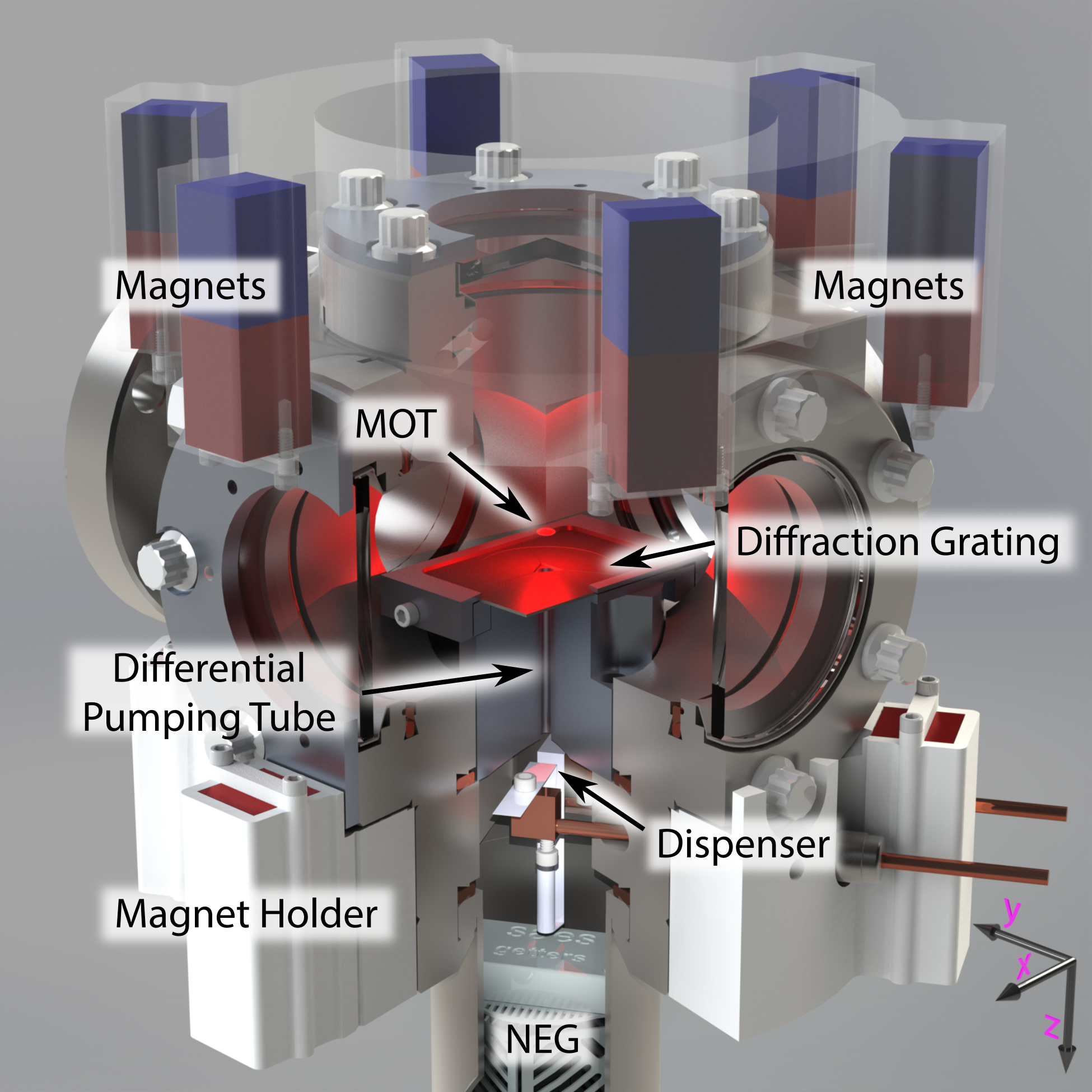Cold Atom Vacuum System

The Technology
NIST scientists have designed a quantum-based vacuum gauge called a cold atom vacuum system (CAVS) that eliminates many of the problems with conventional gauges while delivering much lower measurement uncertainties.
CAVS, which is both a primary standard and absolute sensor of vacuum, consists of an enclosure that is attached to the side of, and open to, a chamber with the vacuum environment of interest. CAVS contains on the order of 1 million ultra-cold alkali atoms suspended in a trap, which fluoresce when excited by a laser beam. The trapped atoms interact with the gas in the vacuum chamber, principally hydrogen molecules, that remains after the chamber is pumped down to ultra-high (< 10-6 Pa) or extreme-high (< 10-10 Pa) vacuum.
Every time a trapped atom is struck by one of the molecules from the vacuum chamber, the collision kicks the cold atom out of the trap and into the chamber, decreasing the amount of fluorescent light emitted. A sensor records the dimming. The faster the light dims, the more molecules are in the vacuum chamber, making the fluorescence level a sensitive measure of pressure. This relationship between the rate of dimming and the number of molecules is predicted by quantum mechanics, which makes the device an intrinsically accurate standard.
Advantages Over Existing Methods
The conventional technology for measuring and controlling high vacuum typically relies on an ionization gauge placed inside the vacuum chamber. Electrons emitted by a heated filament ionize ambient atoms remaining in the chamber. The resulting ion current passes to a collector. The magnitude of that current varies directly with the number of atoms in the chamber. Conversely, the lower the current, the higher the vacuum.
However, ionization gauges require periodic recalibration and are not compatible with the modern version of the International System of Units (SI). CAVS, by contrast, produces measurements that are intrinsically accurate. No calibration is required.
Applications
Numerous industrial processes depend on high vacuums, including depositing scratch-resistant coatings on materials such as eyeglass lenses, manufacturing pharmaceuticals, molding plastics, constructing components of aircraft, and testing instruments destined for use on satellites.
Perhaps no commercial process requires higher vacuum conditions than the fabrication of microelectronics, where devices inside vacuum chambers lay down successive layers of chemicals often only a few atoms thick. That process must be as free as possible of contaminants.
Those and many other processes could benefit from an intrinsically accurate primary vacuum standard.
Key Papers
J. Scherschligt, J.A. Fedchak, D.S. Barker, S. Eckel, N. Klimov, C. Makrides and E. Tiesinga. Development of a new UHV/XHV pressure standard (Cold Atom Vacuum Standard). Metrologia. Nov. 3, 2017. DOI: 10.1088/1681-7575/aa8a7b
J. Scherschligt, J.A. Fedchak, Z. Ahmed, D.S. Barker, K. Douglass, S. Eckel, J. Hendricks, N. Klimov, T. Purdy, J. Ricker, R. Singh and J. Stone. Quantum-based vacuum metrology at NIST. Journal of Vacuum Science & Technology A. June 20, 2018. DOI: 10.1116/1.5033568
E. Norrgard, D. Barker, J. Fedchak, N. Klimov, J. Scherschligt and S. Eckel. A 3D-printed alkali metal dispenser. Review of Scientific Instruments. May 1, 2018. DOI: 10.1063/1.5023906
S. Eckel, D.S. Barker, J.A. Fedchak, N. Klimov, E. Norrgard, J. Scherschligt, C. Makrides and E. Tiesinga. Challenges to miniaturizing cold atom technology for deployable vacuum metrology. Metrologia. Sept. 14, 2018. DOI: 10.1088/1681-7575/aadbe4
W. McGehee, W. Zhu, D. Barker, D. Westly, A. Yulaev, N. Klimov, A. Agrawal, S. Eckel, V. Aksyuk and J. McClelland. Magneto-optical trapping using planar optics. New Journal of Physics. Jan. 29, 2021. DOI: 10.1088/1367-2630/abdce3
S. Eckel, D. Barker, E. Norrgard and J. Scherschligt. PyLCP: A python package for computing laser cooling physics. Computer Physics Communications. Sept. 9, 2021. DOI: 10.1016/j.cpc.2021.108166
D. Barker, N. Klimov, E. Tiesinga, J. Fedchak, J. Scherschligt and S. Eckel. Progress towards comparison of quantum and classical vacuum standards. Measurement: Sensors. Sept. 22, 2021. DOI: h10.1016/j.measen.2021.100229
D. Barker, E. Norrgard, N. Klimov, J. Fedchak, J. Scherschligt and S. Eckel. Lambda-enhanced gray molasses in a tetrahedral laser beam geometry. Optics Express. March 14, 2022. DOI: 10.1364/OE.444711
L. Ehinger, B. Acharya, D. Barker, , J. Fedchak, , J. Scherschligt, , E. Tiesinga and S. Eckel. Comparison of two multiplexed portable cold atom vacuum standards. AVS Quantum Science. July 15, 2022. DOI: 10.1116/5.0095011
D. Barker, B. Acharya, J. Fedchak, N. Klimov, E. Norrgard, J. Scherschligt, E. Tiesinga and S. Eckel. Precise Quantum Measurement of Vacuum with Cold Atoms. Review of Scientific Instruments. Dec. 20, 2022. DOI: 10.1063/5.0120500
Daniel S. Barker, James A. Fedchak, Jacek Kłos, Julia Scherschligt, Abrar A. Sheikh, Eite Tiesinga and Stephen P. Eckel. Accurate measurement of the loss rate of cold atoms due to background gas collisions for the quantum-based cold atom vacuum standard. AVS Quantum Science. Published online Aug. 1, 2023. DOI: 10.1116/5.0147686
Key Patents
S. Eckel et al. Uniaxial counter-propagating monolaser atom trap. United States Patent US 11,291,103. Oct. 10, 2019.
Contacts
-
(301) 975-8571

